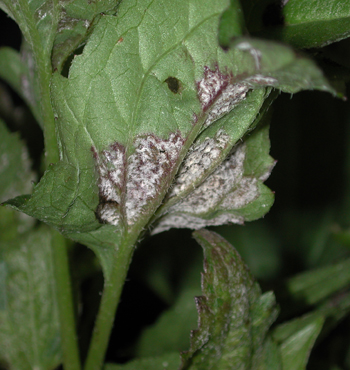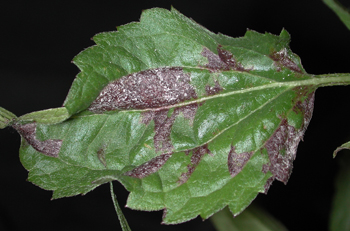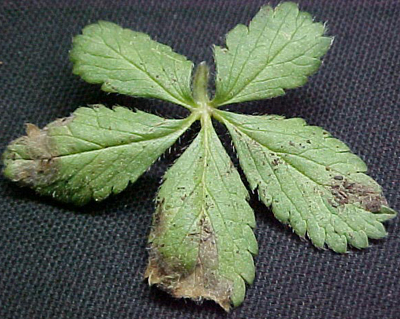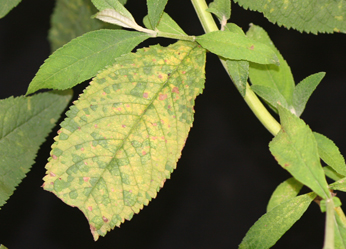Downy mildew
July 7, 2015
Mildews
Pathogen
Peronospora spp. and Plasmopara spp.
Hosts
Many fungi cause downy mildew. Each has a fairly limited host range. Common hosts include: Buddleia, Delphinium, Dianthus, Dicentra, Geum, Helianthus, Iberis, Lamium, Lathyrus, Oenothera, Papaver, Potentilla, Primula, Rudbeckia, Veronica and Viola.
Symptoms
Fuzzy, gray to black mold develops on the undersides of infected leaves. Chlorotic or necrotic lesions appear on the upper surfaces of infected leaves.


Downy mildew on the underside of Rudbeckia foliage produces a thick, whitish, fuzzy growth. At right, lesions on the upper surface. Note the angular edges of lesions that are bordered by the leaf venation.
Lesions may have angular edges; some lesions are bordered by veins. Infected foliage may be cupped, and new growth may become distorted. Severely affected plants are stunted. Some seedlings can be infected systemically, causing new growth to be stunted and severely distorted.

Lesion on Potentilla foliage.
Spread
Spores are readily released and carried by air currents. Peak spore release often occurs when relative humidity rapidly decreases, which typically occurs in the morning. Some downy mildews are spread by contaminated seed; others are effectively spread on vegetative cuttings and seedlings.

Mottling symptoms. Note the angular edges of the lesions.
Management
Scout susceptible incoming plant material carefully for signs of downy mildew paying careful attention to leaf undersides. Remove and destroy infected plants. Do not compost the plant debris. Warm days and cool nights with high humidity are favorable conditions for downy mildew spore production. Maintain good air circulation and increase night temperatures in greenhouses. Fungicides should be used preventively on especially susceptible crops. Downy mildews are capable of developing resistance to several effective systemic fungicides. Rotate use of systemic fungicides with protectants to slow resistance development.

Downward curling and yellowing of Veronica leaves caused by downy mildew.
Print a PDF of this page: Downy mildew



 Print
Print Email
Email



